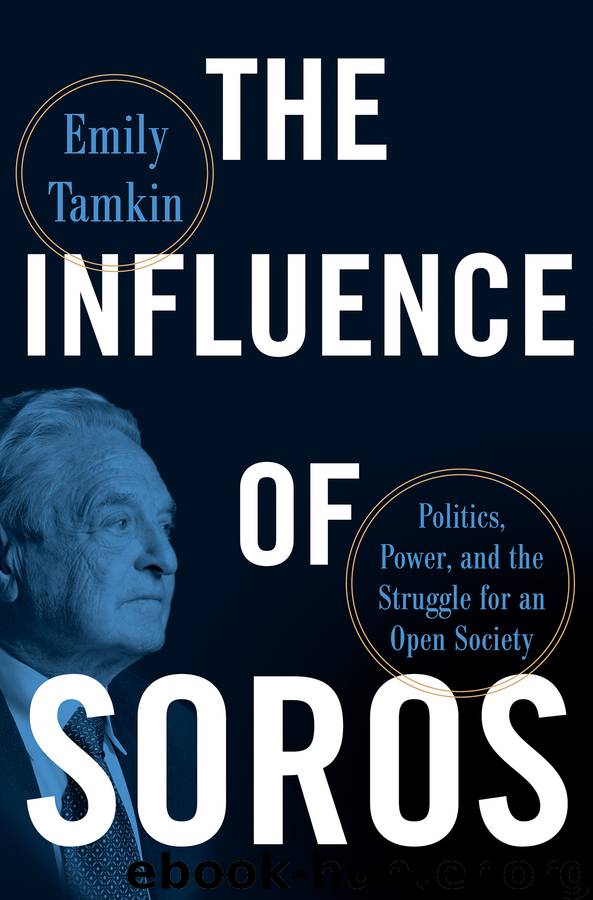The Influence of Soros by Emily Tamkin

Author:Emily Tamkin
Language: eng
Format: epub
Publisher: HarperCollins
Published: 2020-07-06T16:00:00+00:00
In 2000, Open Society held its national board meeting in Baltimore. Soros spent the earlier part of the day telling reporters that his sidekick, Stanley Druckenmiller, the man who had run his hedge fund, Quantum, for twelve years, would be resigning. Quantum was down 21 percent for the year that year. After his press conference, Soros headed to Baltimore, where he went to the Living Classrooms Foundation and chatted with four sixteen-year-old boys, asking about how much money there was in drug running.
He then spoke with Beilenson, who told Soros what he had told the other visitors earlier in the day. The city, now under a new mayor, Martin O’Malley, had not found the funds needed to expand the pilot programs Open Society was funding. Beilenson had asked for $25 million in state aid. Maryland’s governor had approved $8 million.25
(Beilenson, for his part, remembers the day “very clearly.” Soros, he said, was “quite personable. I was kind of surprised.”)26
When, during that visit, O’Malley toasted Soros, saying, “I just want to say that you had the leadership and courage to invest in this city when others were not wise enough,” and mentioned in his speech the governor’s partial funding of drug treatment, Soros said, “I wish to express my disappointment at the grant that the mayor referred to. I am less of a politician than he is . . . we have shown that there is a way of dealing with the problems of drugs that had not been tried at the time. If we could get 60,000 people into treatment we would have real statistics. There has to be a systematic approach to the problem.”27
The incident works as a representation of the shortcomings of philanthropy in the criminal justice reform space. Donor money is a start, and it allows advocates and activists to do what they wouldn’t otherwise be able to do. “The elected officials by themselves can’t solve the problem,” Schmoke told me. “This is a multifaceted issue. It needs all hands on deck. It was very helpful that he made the investment that he did.”28 But philanthropy alone can’t get governments at the local, state, and federal level to work in tandem. Philanthropy alone isn’t enough to reform police departments. Philanthropy alone can’t address the racist underpinnings of the U.S. criminal justice system. It alone can’t get people to change popular attitudes. “Even today, there continues to be a disproportionate response to crime,” Nicole Porter, from the Sentencing Project, told me, adding, “even something that might be relatively minor might elicit the general response of, throw the book at somebody.” But philanthropy alone can make political actors think that they’ve done something, when in fact what they’re toasting is a grant that’s but a third of what was requested.
Confusing the celebration of small steps with meaningful change continues to be a problem, said Jonathan Blanks, a research associate in the Project on Criminal Justice at the Cato Institute, a think tank founded as the Charles Koch Foundation and
Download
This site does not store any files on its server. We only index and link to content provided by other sites. Please contact the content providers to delete copyright contents if any and email us, we'll remove relevant links or contents immediately.
| Anarchism | Communism & Socialism |
| Conservatism & Liberalism | Democracy |
| Fascism | Libertarianism |
| Nationalism | Radicalism |
| Utopian |
The Secret History by Donna Tartt(16658)
The Social Justice Warrior Handbook by Lisa De Pasquale(11494)
Thirteen Reasons Why by Jay Asher(7801)
This Is How You Lose Her by Junot Diaz(5799)
Weapons of Math Destruction by Cathy O'Neil(5046)
Zero to One by Peter Thiel(4834)
The Myth of the Strong Leader by Archie Brown(4795)
Promise Me, Dad by Joe Biden(4455)
Beartown by Fredrik Backman(4433)
Stone's Rules by Roger Stone(4422)
How Democracies Die by Steven Levitsky & Daniel Ziblatt(4413)
The Fire Next Time by James Baldwin(4350)
100 Deadly Skills by Clint Emerson(4085)
A Higher Loyalty: Truth, Lies, and Leadership by James Comey(4039)
Rise and Kill First by Ronen Bergman(4020)
The David Icke Guide to the Global Conspiracy (and how to end it) by David Icke(3891)
The Farm by Tom Rob Smith(3878)
Secrecy World by Jake Bernstein(3788)
The Doomsday Machine by Daniel Ellsberg(3737)
